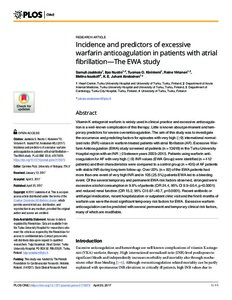Incidence and predictors of excessive warfarin anticoagulation in patients with atrial fibrillation-The EWA study
K. E. Juhani Airaksinen; Raine Virtanen; Tuomas O. Kiviniemi; Ilpo Nuotio; Samuli Jaakkola; Melina Issakoff
Incidence and predictors of excessive warfarin anticoagulation in patients with atrial fibrillation-The EWA study
K. E. Juhani Airaksinen
Raine Virtanen
Tuomas O. Kiviniemi
Ilpo Nuotio
Samuli Jaakkola
Melina Issakoff
PUBLIC LIBRARY SCIENCE
Julkaisun pysyvä osoite on:
https://urn.fi/URN:NBN:fi-fe2021042716860
https://urn.fi/URN:NBN:fi-fe2021042716860
Tiivistelmä
Vitamin K antagonist warfarin is widely used in clinical practice and excessive anticoagulation is a well-known complication of this therapy. Little is known about permanent and temporary predictors for severe overanticoagulation. The aim of this study was to investigate the occurrence and predicting factors for episodes with very high (>= 9) international normalized ratio (INR) values in warfarin treated patients with atrial fibrillation (AF). Excessive Warfarin Anticoagulation (EWA) study screened all patients (n = 13618) in the Turku University Hospital region with an INR >= 2 between years 2003-2015. Patients using warfarin anticoagulation for AF with very high (>= 9) INR values (EWA Group) were identified (n = 412 patients) and their characteristics were compared to a control group (n = 405) of AF patients with stable INR during long-term follow-up. Over 20% (n = 92) of the EWA patients had more than one event of very high INR and in 105 (25.5%) patients EWA led to a bleeding event. Of the several temporary and permanent EWA risk factors observed, strongest were excessive alcohol consumption in 9.6% of patients (OR 24.4, 95% CI 9.9-50.4, p<0.0001) and reduced renal function (OR 15.2, 95% CI 5.67-40.7, p<0.0001). Recent antibiotic or antifungal medication, recent hospitalization or outpatient clinic visit and the first 6 months of warfarin use were the most significant temporary risk factors for EWA. Excessive warfarin anticoagulation can be predicted with several permanent and temporary clinical risk factors, many of which are modifiable.
Kokoelmat
- Rinnakkaistallenteet [19207]
